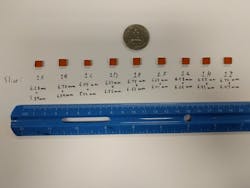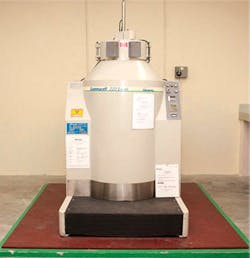A team of researchers led by Myungkoo Kang, an assistant professor of ceramic engineering at Alfred University, and Kathleen Richardson, an optics and photonics professor at the University of Central Florida (UCF), recently made the discovery of “self-healing” properties of a chalcogenide glass after exposing it to gamma radiation (see video).
Chalcogenide optical glass materials are alloys made by combining chalcogen elements such as sulfur, selenium, or tellurium. They’re emerging as an important alternative to traditional glass materials (think germanium), which are quickly becoming scarce and prohibitively expensive, for infrared (IR) systems.
What makes chalcogenide glasses special for the IR? No oxygen. “When chalcogen elements bond together, they make IR transparent materials with large atoms and weak bonds,” says Richardson.
The “self-healing” comes from the ability of these bonds to be distorted when exposed to radiation, but then the large atoms with weak bonds “relax” at room temperature and return to their pre-distorted state.
By blending these core elements together or with other elements such as germanium, antimony, or sulfur in various ratios, chalcogenide glass properties can be tailored for specific applications. Think of them as a bit like Legos, because you can assemble them however you want.
“I was instantly fascinated by chalcogenide glasses because the name is decidedly difficult to pronounce,” says Kang. “What an exotic name! Chalcogenide glasses are nothing like typical soda-lime-silicate oxide glasses used for windows. These glasses have remarkable optical properties, so they’re a promising candidate for a wide range of applications like optical fiber communications, phase-change materials, and thermal imaging and sensing, and many other innovative functionalities not possible with conventional oxide glasses.”
Working with colleagues at Singapore University of Technology and Design, MIT, Clemson University, and Ursinus College, the team made their “self-healing” discovery while testing a chalcogenide glass made of germanium, antimony, and selenium (GeSbSe; see Fig. 1) for use within a satellite’s circuitry. After being exposed to gamma radiation conditions such as those it would encounter out in space, the glass developed microscopic defects that were repaired within a room temperature environment.
Optical changes via gamma radiation
The team fabricated the chalcogenide glass used for their work at in a furnace at UCF, which was a tricky process that must be extremely precise to ensure the glass isn’t exposed to moisture, oxygen, or other contaminants.
“We used germanium antimony selenide (GeSbSe) as testbed chalcogenide glasses and subjected them to gamma radiation (see Fig. 2) with a wide range of doses,” explains Kang, who analyzed the optical properties of the materials before and after radiation exposure. “GeSbSe glasses exhibited instant optical changes upon gamma radiation and subsequent relaxation to a pre-radiation level, which indicates their self-healing. This fascinating, yet enigmatic, phenomenon was motivation for our team to search for its fundamental mechanism.”
While the impact of gamma exposure on chalcogenide glass and its subsequent relaxation “were previously reported, these earlier studies not only used a limited range of radiation doses but also focused exclusively on the structural aspect of target glasses at one post-radiation stage,” says Kang.
“Our data represents, to the best of our knowledge, the first-ever integrated analysis of such systematic material evolution, which allows us to elucidate the microscopic origin behind the self-healing process in chalcogenide glasses under extreme conditions,” he says.
One of the challenges involved for the team was that upon gamma irradiation, “various properties of samples needed to be monitored at short intervals to keep track of their time-dependent evolution,” says Kang. “To orchestrate such time-sensitive analyses, our international group of researchers had to send irradiated samples back and forth on time. It was a huge challenge for us, but very fulfilling teamwork.”
It required a lot of detective work to identify an atomistic origin behind the self-healing of glasses upon gamma irradiation, because the data from each individual characterization tool was somewhat counterintuitive. “But when we cross-correlated the data from multifaceted characterization tools, a ‘Eureka!’ moment hit and finally allowed us to understand the mechanism behind the otherwise enigmatic and fascinating phenomenon,” Kang adds.
Sensors for extreme space or radioactive environments
The chalcogenide GeSbS glasses used for the team’s study can be deployed “as robust, reversible radiation sensors within extreme environments such as space and ground-based radioactive facilities where gamma ray is characteristically abundant,” says Kang. “One of the representative military applications is a nuclear detonation detection device capable of indicating and pinpointing the direction of a nuclear explosion as part of an effort to prevent the spread of nuclear weapons.”
Next, the researchers plan to design a space-based experiment to subject chalcogenide GeSbS glasses to cosmic rays—such as alpha, beta, gamma, x-ray, and galactic cosmic radiation—for a long period of time to explore their irradiation behavior during an extreme range of temperatures (between 250°F in direct sunlight and -250°F at opposition to the Sun) as well as their post-radiation relaxation kinetics over the extreme range.
“It would be a true test to validate the applicability of the glasses to the extreme environment as powerful, versatile radiation monitoring sensors—with great implications for our national defense and security,” says Kang.
The team’s research was funded by the U.S. Defense Threat Reduction Agency.
FURTHER READING
M. Kang et al., MRS Bull., 49, 778–786 (2024); https://doi.org/10.1557/s43577-024-00693-x.
About the Author
Sally Cole Johnson
Editor in Chief
Sally Cole Johnson, Laser Focus World’s editor in chief, is a science and technology journalist who specializes in physics and semiconductors.


